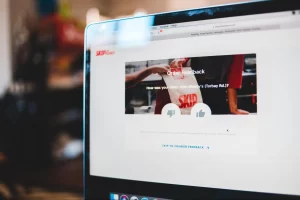19 Ways Businesses Adapt to Industry Trends & Stay Ahead of The Curve
Staying ahead of industry trends is crucial for business success in today’s fast-paced world. This article presents practical strategies, backed by expert insights, to help businesses adapt and thrive amidst constant change. From leveraging financial forecasting to engaging with industry insiders, these methods offer concrete ways to anticipate and respond to market shifts.
- Leverage Dynamic Financial Forecasting
- Combine Multiple Industry Information Sources
- Explain Strategies to Peers
- Curate Focused Industry Newsletters
- Conduct Competitive Immersion Days
- Build Relationships with Industry Insiders
- Test New Ideas with Select Groups
- Reverse-Engineer Job Postings
- Analyze Data from Legal Marketing Campaigns
- Research Global Sun Protection Innovations
- Join Relevant Industry Associations
- Gain Perspective from Outside Your Industry
- Engage Directly with Fitness Community
- Listen to Clients and Frontline Employees
- Commit to Structured Trend Analysis
- Engage in Parenting Forums
- Subscribe to Management Publications
- Follow Thought Leaders on Social Media
- Analyze Business Metrics and Market Research
Leverage Dynamic Financial Forecasting
Staying updated on industry trends and adapting business strategies is essential for success in a dynamic market. This requires a continuous effort to understand external shifts and translate them into internal actions. My approach involves regular market analysis, keeping an eye on competitors, and engaging with various industry resources. I find that talking to colleagues across different functions also provides valuable grassroots insights that complement broader market data.
A particularly valuable method I use for staying ahead of the curve is leveraging robust financial forecasting that actively incorporates dynamic external drivers and scenario planning. Instead of just projecting past performance, which can be like “driving forward while looking into a rearview mirror” in a fast-changing world, this approach focuses on identifying key factors outside the business that can impact future results, such as changes in customer demand, competitor actions, or economic conditions. Quantifying these external drivers and modeling potential scenarios allows us to anticipate their financial impact.
Early in my finance career, I experienced the limitations of forecasting based purely on historical numbers. I was tasked with forecasting financials for a specific region and initially focused heavily on past data. My manager provided crucial feedback, emphasizing the need to truly understand how the business operated and generated revenue in that market, including the competitive landscape. This personal anecdote underscored that reliable forecasting and strategic planning require combining financial analysis with a deep understanding of operational drivers and market dynamics, especially when considering how external trends might affect future performance.
This experience solidified my belief in tying trend analysis directly into strategic financial tools like forecasts. By modeling different scenarios based on identified external drivers, for instance, the impact of new regulations or market disruptions, we gain a “little glimpse of what lies ahead”. This helps in proactively identifying potential financial challenges and opportunities before they fully materialize.
For this method to be truly actionable, I recommend reviewing and updating the forecast regularly, ideally monthly. This ensures you maintain a clear view of the near future and can make adjustments as new information on trends or drivers emerges.
 Enoch Olalusi
Enoch Olalusi
CEO, Hustle Strikers
Combine Multiple Industry Information Sources
Staying ahead in digital marketing requires constant learning and adaptation. Personally, I stay updated by subscribing to industry-specific newsletters, such as those from AdExchanger, Marketing Brew, Digiday, and Think with Google. These give me daily insights into what’s evolving in the marketing, media buying, and AdTech landscape.
In addition to that, I regularly read publications from key players like Meta, Google, LinkedIn, and HubSpot. I also make it a priority to attend conferences and industry events, where I not only learn from expert panels but also gain real-world insights through networking with fellow professionals. This human-to-human exchange often gives me a pulse on what’s actually working in the field before it becomes mainstream.
Combining these methods ensures I can quickly adapt strategies for clients and my own initiatives—whether it’s embracing a new platform, integrating a tool, or testing an innovative campaign model.
 Maksym Zakharko
Maksym Zakharko
CMO, maksymzakharko.com
Explain Strategies to Peers
I read two industry newsletters every day—usually just a quick scan, but over time you start noticing trends, repeated topics, or when bigger players begin moving in a certain direction. I also stay in regular contact with peers who are in similar roles and situations. Those conversations are often even more valuable because you hear what’s actually working on the ground.
What helps me the most, though, is explaining my own strategy to peers. When I talk it through, I often catch weak spots or areas that could be improved myself without anybody telling me. Just saying it out loud helps me reflect and refine.
 Heinz Klemann
Heinz Klemann
Senior Marketing Consultant, BeastBI GmbH
Curate Focused Industry Newsletters
I live on curated newsletters and niche Substacks—they cut through the noise way faster than doomscrolling Twitter or LinkedIn all day. Stuff like Stratechery or niche industry digests give me sharp insights without drowning me in junk. I scan them every morning with my coffee, pull 1-2 actionable items, and move on. Staying ahead isn’t about knowing *everything*—it’s about catching the right waves early and ignoring the hype.
 Justin Belmont
Justin Belmont
Founder & CEO, Prose
Conduct Competitive Immersion Days
Hi there,
As co-founder and CEO of WDR Aspen, a full-service marketing agency, I’ve found that the most valuable resource for staying ahead of industry curves isn’t a traditional publication or analytics tool–it’s our structured “Competitive Immersion Days.”
Quarterly, our team dedicates a full day to experiencing our clients’ competitors’ customer journeys firsthand. We sign up for services, purchase products, and document the entire experience–from initial touchpoint through post-purchase communication. This hands-on approach reveals emerging UX trends, messaging shifts, and service innovations that analytics alone miss.
This practice has directly informed several pivotal strategy shifts for both our agency and clients, including an overhaul of our onboarding process that increased client retention last year.
Hope this helps with your piece! Let me know if you’d like more insight–I’m happy to share.
Olivier de Ridder
Co-founder & CEO, WDR Aspen
olivier@wdraspen.com
 Olivier De Ridder
Olivier De Ridder
CEO, WDR Aspen
Build Relationships with Industry Insiders
Staying ahead in a fast-changing landscape is all about curiosity and consistency. At Spectup, we’ve built a habit of blending traditional research methods with creative approaches to keep our strategies sharp. Personally, I put a lot of weight on building relationships with founders and experts in niche industries — there’s nothing quite like hearing firsthand what’s actually happening on the ground. One method I swear by is tuning into investor pitch events, even at odd hours, as they often reveal where capital is flowing and which problems investors are excited to solve.
I also find that engaging with tailored, high-quality newsletters can be surprisingly insightful. For instance, a curated one like The Information or CB Insights often highlights the connections nobody else is making yet. But what truly makes the difference is reflection. One time, while managing a client at Spectup, we noticed a subtle investor shift towards sustainability-focused startups long before it became a buzzword. By cross-referencing reports, investor sentiment, and social conversations, we helped that client reposition their technology as a sustainability enabler, leading to a rewarding funding round. And when all else fails, a coffee conversation with one of our more analytics-savvy team members often uncovers things I might have overlooked.
 Niclas Schlopsna
Niclas Schlopsna
Managing Consultant and CEO, spectup
Test New Ideas with Select Groups
Staying Ahead of Industry Trends: My Go-To Method for Adapting Business Strategy
Staying ahead in business means having your radar tuned to what’s next, not just what’s now. I make trend-spotting a regular habit, not a once-a-year scramble.
How I Stay Updated
I blend classic research with real-time insights. My routine includes:
– Reading industry journals, trade publications, and trusted blogs for deep dives and emerging signals.
– Attending conferences and networking events–nothing beats hearing what’s bubbling up straight from the source.
– Following thought leaders and competitors on social media to catch shifts as they happen.
– Keeping a pulse on customer feedback and market data to spot changes in behavior before they become headlines.
Adapting My Strategy
When a trend emerges, I don’t just observe–I test. I’ll pilot a new idea with a select group of clients or team members, gather feedback, and iterate quickly. This approach keeps my business nimble and ready to pivot, whether it’s a new technology, a shift in customer expectations, or an industry shake-up.
One Resource I Rely On
Google Trends is my go-to tool for real-time market signals. It’s free, fast, and gives a snapshot of what people are searching for right now. I use it to validate hunches, spot rising topics, and fine-tune messaging. It’s like having a window into the collective curiosity of the market.
That said, Google Trends isn’t perfect–it only shows relative search volume and is limited to Google’s data. For deeper dives, I’ll pair it with tools like Exploding Topics or Glimpse, which surface emerging trends and provide broader context. The combination helps me catch what’s next, not just what’s now.
Bottom Line
Staying current isn’t about chasing every shiny object–it’s about having a system to spot what matters, adapt fast, and keep your business future-ready. Curiosity and agility win every time.
 Nancy Capistran
Nancy Capistran
Founder, Executive Coach, Crisis Advisor, Capistran Leadership
Reverse-Engineer Job Postings
When it comes to staying ahead of industry trends, I’ve found that traditional sources–newsletters, blogs, Twitter–are fine for keeping up, but not great for getting ahead. They tell you what’s happening, not what’s about to happen.
So here’s the one method I swear by: I reverse-engineer job postings.
Let me explain.
Most companies–especially Big Tech or fast-moving startups–reveal what they’re planning long before they announce anything publicly. You just have to read between the lines of their hiring. If Meta is suddenly hiring a cluster of engineers with ARKit experience in Tel Aviv, or if OpenAI is looking for someone who specializes in voice synthesis QA, that’s a whisper of what’s coming down the pipeline. It’s trend-forecasting through talent.
Every Sunday, I spend about 20 minutes scanning job boards–not just the roles, but the phrasing, tech stacks, and “nice-to-haves.” Those footnotes are often where the roadmap leaks. It’s how I first noticed the growing demand for “agentic” AI systems before it became the new buzzword, or how I knew which markets were heating up for voice-first UX.
Then, I take those signals and play offense: adjust our product roadmap, experiment with messaging, or start doing content outreach in spaces that haven’t hit saturation yet.
So yeah–while everyone’s refreshing LinkedIn and Substack, I’m treating job descriptions like tarot cards.
 Derek Pankaew
Derek Pankaew
CEO & Founder, Listening.com
Analyze Data from Legal Marketing Campaigns
Staying ahead in legal marketing and SEO requires constant evolution, as what worked yesterday might not work tomorrow. I prioritize reserving time every week for proactive learning—analyzing algorithm updates, emerging technologies, and shifts in user behavior. One valuable method is subscribing to a curated mix of industry newsletters and private communities; I rely particularly on Search Engine Roundtable. It doesn’t just report on what’s happening—it explains what those changes mean for real-world strategies, especially for specialized fields like law.
I also actively test and implement new approaches within controlled environments. With access to hundreds of legal marketing campaigns, I’m able to spot trends early—sometimes before they’re reported—by monitoring aggregate data for sudden shifts in rankings, click-through rates, or search intent. I also encourage open dialogue within my team; we share observations and brainstorm responses to new developments, ensuring we’re not reacting in isolation but learning collectively.
Adaptation comes down to being curious and critical. It’s not enough to know what’s changing; you have to understand why it matters and be willing to experiment. By leveraging trusted industry resources like Search Engine Roundtable and combining them with firsthand data analysis and a collaborative approach, I’m able to develop strategies that keep my clients ahead of the curve.
 Jason Bland
Jason Bland
Co-Founder, Custom Legal Marketing
Research Global Sun Protection Innovations
To stay updated on industry trends and adapt my business strategies, I make it a priority to connect with other entrepreneurs and industry experts. I actively follow niche blogs, attend webinars, and participate in conferences related to both fashion and sun protection. One resource I find particularly valuable is the ongoing research coming out of South Korea, a global leader in sun protection innovation. This has helped me understand both the advancements in fabric technology and emerging market trends that align with our mission to offer stylish, sun-safe beachwear.
By staying informed about the latest developments, I can incorporate new materials and design elements that not only resonate with our customers’ needs but also position Tied Sunwear as a forward-thinking brand. For instance, our fabric which offers UPF 50+ protection without chemical treatments was developed based on insights from global experts. This focus on cutting-edge research allows us to deliver products that combine both fashion and function in meaningful ways.
I make sure to listen to our customers, who are incredibly vocal about what they want from their sun protection. We regularly receive feedback from women who are tired of choosing between fashion and safety when it comes to beachwear. It’s through this direct connection that we’ve been able to refine our designs, offering them comfortable, stylish alternatives that meet both their fashion-forward sensibilities and health-conscious needs.
Incorporating this type of dynamic learning and customer-driven development has allowed me to stay ahead of the curve and create a brand that not only responds to trends but shapes them, especially in the growing market of sun-safe fashion.
 Laura Kosmorsky
Laura Kosmorsky
Co-Founder, Tied Sunwear
Join Relevant Industry Associations
I’ve found that being an active member of industry associations is one of the most effective ways to stay current on trends and developments that influence business strategy. As a recruiting firm leader, I belong to organizations that support staffing professionals like the ASA and NAPS, as well as trade associations in our client industries, such as the National Association of Manufacturers and Associated General Contractors. This dual membership helps me stay informed about changes within both my own sector and the industries we serve.
These groups provide a wide range of valuable resources like newsletters, research reports, and member-only content that highlight shifts in hiring demand, emerging skill gaps, and regulatory updates. That information directly shapes how we forecast client needs and position our services. Just as important, these associations offer opportunities for direct interaction with other professionals, whether that’s in an online forum or at the conferences, trade shows, and similar events they host. Having candid conversations with peers and industry leaders often reveals emerging trends before they hit the mainstream.
 David Case
David Case
President, Advastar
Gain Perspective from Outside Your Industry
Ironically, staying ahead of industry trends often requires looking beyond your work. When you’re deeply immersed in your field, it’s easy to develop tunnel vision. You become so focused on the day-to-day operations that you miss the true impact of broader market shifts happening around you.
For example, one major shift in recruiting recently has been the multi-stage interview process. Time-to-hire has expanded exponentially in some areas due to an increasingly stringent evaluation period.
While I had been tracking this trend, I was watching it unfold gradually. That meant the impact felt incremental rather than urgent. It wasn’t until I spoke with friends and family outside the recruiting space—people experiencing the effects of slower hiring processes—that I realized just how disruptive this shift had become.
Hearing how these changes were playing out in real lives gave me a different perspective. It snapped the trend into focus as a major shift, not merely an evolution. That perspective gave me the impetus to adapt our approach sooner and more comprehensively. By stepping outside the bubble of my own industry, I was able to recognize the temperature change for what it really was—and make the appropriate moves to stay ahead of it, such as increasing communication with candidates.
 Michael Moran
Michael Moran
Owner and President, Green Lion Search
Engage Directly with Fitness Community
Staying ahead of industry trends is crucial in an ever-evolving space like fitness, where new innovations, technologies, and consumer preferences constantly shift. At Studio Three, we keep a pulse on emerging trends by engaging directly with our community and staying active in conversations across both professional networks and fitness-focused platforms. We rely heavily on feedback from our members, which provides us with invaluable insight into their evolving needs and expectations. Whether it’s adapting our classes to incorporate the latest in recovery techniques or enhancing the training experience with new equipment, we aim to provide what’s most relevant and effective.
A particularly valuable resource is fitness industry conferences and workshops. These gatherings allow us to connect with other leaders and influencers in the wellness space, offering firsthand access to upcoming trends. At a recent event, for instance, we explored innovations in recovery methods and how they could seamlessly integrate into our programs. This knowledge empowered us to enhance the recovery component of our classes, further solidifying our commitment to a holistic approach that balances strength, cardio, and recovery.
For us, staying updated means more than just knowing what’s next; it’s about actively incorporating those insights into how we support our members. Being agile in the fitness industry requires continuous learning and adaptation. We don’t just observe trends; we test and experiment with them in real-time, allowing us to adjust our programs based on how they align with our core mission of fostering both physical and mental well-being. Our community has always been at the heart of this evolution, and their stories fuel our passion for offering a dynamic fitness experience that truly empowers. By blending expert knowledge with a deep understanding of our members’ needs, we ensure that Studio Three remains a trusted space for personal growth and transformation.
 Danielle Beattie
Danielle Beattie
Director of National Marketing, Studio Three
Listen to Clients and Frontline Employees
I stay updated by staying connected. I talk to members, team leaders, and partners weekly. I pay attention to what clients request, what frustrates them, and where we fall short. I also listen to team feedback. Frontline employees often see shifts before industry reports do. Trends don’t start in trade magazines; they start in conversations. If a guest starts asking for new grooming services or wants different products, I treat that as a signal. When enough people speak up, we respond.
One resource I trust is peer groups. I belong to a network where operators in other industries share what’s working for them. You spot patterns faster when you hear how restaurant owners, gym owners, and auto detailers are adapting to the same economic forces. You start seeing what’s trend versus what’s noise. For example, when several unrelated industries talked about membership retention strategies shifting after 2020, we rebuilt our client engagement model. We improved appointment reminders, added loyalty touches, and built more personal follow-up systems. That came directly from peers outside grooming, not a barbering playbook.
I don’t follow trends for show. I watch for changes that affect how our clients want to be treated, how our team wants to work, and where we can build long-term value. When you’ve built something through a recession, you learn to filter hype and focus on what drives results. I rely on data, people, and hard-won experience to guide our decisions.
 Ben Davis
Ben Davis
CEO, The Gents Place
Commit to Structured Trend Analysis
Staying updated on industry trends demands a structured approach. I commit time each week to review sector-specific research reports, listen to business-focused podcasts, and engage directly with peers through curated executive communities. These practices allow me to hear what is working across different sectors. I prioritize verified data over opinion pieces to ensure decisions are based on evidence, not hype. Making this a non-negotiable routine has been crucial for adapting strategies quickly when market conditions shift.
One resource I find consistently valuable is CB Insights. Their reports and market maps deliver clear, data-driven insights about emerging trends across industries. I use their briefings to identify shifts early, whether it is in consumer behavior, technology, or operational best practices. These insights help me pressure-test our marketing and product strategies against broader economic or sector changes before they become critical. Pairing this with direct customer feedback creates a strong system for refining strategies.
Having built marketing and product teams across early childhood education, renewable energy, and women’s health sectors, I learned that no amount of intuition replaces structured trend tracking. It protects teams from reactive decision-making and gives leadership the confidence to focus resources on what matters most. Consistency in tracking and disciplined analysis are non-negotiable for any marketing leader who wants to drive sustained growth.
 Lisa Walthers
Lisa Walthers
CMO, Upkid
Engage in Parenting Forums
Staying updated on industry trends is crucial for adapting your business strategies, especially in a field like child development and parenting. Research shows that parents today are more informed than ever, but they are also overwhelmed with information. As a result, finding reliable resources that help cut through the noise is key. Personally, I find that staying connected with experts and engaging with parents directly through online communities is invaluable. It helps me stay on top of new parenting trends, concerns, and best practices, ensuring that my products and services remain relevant and effective.
When it comes to adapting strategies based on what I learn, I focus on understanding how different stages of child development affect everyday parenting. For example, during the toddler years, many parents struggle with balancing play and screen time. I use insights from these conversations to improve educational toys that encourage hands-on, screen-free learning. If parents understand the importance of limiting screen exposure for younger children, they are more likely to seek out products that support cognitive growth through physical interaction, like puzzles or building blocks. It’s all about meeting parents where they are and offering solutions that make their lives easier.
The resource I find especially useful is social media groups and parenting forums, where real-time conversations about children’s behaviors and development occur. These platforms allow me to see firsthand what issues parents are facing, whether it’s a challenge with oral health habits or finding educational activities that align with their child’s stage of growth. By listening to these discussions, I can adapt my business strategies to offer products and advice that are directly aligned with parents’ needs and concerns.
For example, I’ve learned that many parents are looking for ways to introduce dental care to young children without the struggle. This feedback has inspired new toy designs that combine play with early dental education, making it easier for parents to teach good habits.
For parents, staying up to date on trends and feedback directly benefits them. By constantly evolving and adapting my strategies, I’m able to offer tools and advice that are practical, safe, and fun for kids. As trends shift, I can introduce new, helpful products that make parenting a little less stressful and a lot more rewarding, all while supporting their child’s development.
 Mona Hovaizi
Mona Hovaizi
Founder & CEO, Gaux
Subscribe to Management Publications
In my experience as a business strategist, staying updated on industry trends and adapting business strategies accordingly is essential for maintaining a competitive edge. One particularly valuable resource I’ve found is subscribing to industry-specific publications and thought leaders’ newsletters. For instance, platforms like MIT Sloan Management Review and The Conference Board provide in-depth analyses and insights into emerging trends and strategic management practices. Regularly engaging with such content allows me to anticipate shifts in the market and adjust strategies proactively. Additionally, participating in professional networks and online communities, such as LinkedIn groups and industry forums, facilitates real-time discussions and knowledge sharing with peers, further enriching my understanding of evolving trends. By combining these resources, I can make informed decisions and implement strategies that align with the current and future landscape of the industry.
 Bowen He
Bowen He
Director, Webzilla Digital Marketing
Follow Thought Leaders on Social Media
To stay updated on industry trends, I prioritize constant learning through a mix of resources. One method I find particularly valuable is following thought leaders and industry experts on platforms like LinkedIn and Twitter. These insights often give me early access to emerging trends, new technologies, and shifts in market dynamics.
I also make it a point to engage in community discussions—whether it’s through networking events, online forums, or masterminds. This allows me to get a real-time pulse on what’s working for others and what’s not.
Another key strategy is data-driven decision-making. I regularly analyze business metrics and market research reports to spot patterns and opportunities, helping me pivot or double down when necessary. Staying nimble and continuously gathering insights from both experts and peers ensures that my business can adapt quickly to evolving trends.
 Dave Lavinsky
Dave Lavinsky
President, PlanPros
Analyze Business Metrics and Market Research
To stay on top of industry trends, I make it a point to dedicate time daily to checking out newsletters and reports that are specific to my industry. It helps me sift through the noise and focus on what truly matters. One resource I really love is TrendWatching. They provide insights into emerging consumer behaviors and innovations, which is incredibly valuable for spotting changes before they hit the mainstream. Beyond that, I’m always tuning into webinars, podcasts, and social media accounts from thought leaders to get real-time updates and fresh ideas. Combining these methods keeps me informed and helps me stay ahead of the curve, adapting our strategies in time to capitalize on new opportunities. It’s all about being proactive and anticipating what’s coming down the line.
 Nikita Sherbina
Nikita Sherbina
Co-Founder & CEO, AIScreen







































